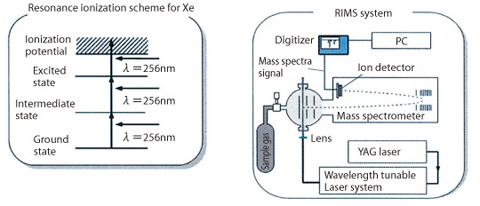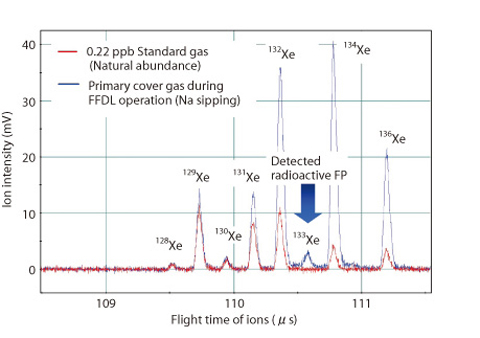
Photo1-1 RIMS System

Fig.1-37 Principle of Resonance Ionization and RIMS System

Fig.1-38 Mass Spectra of Xe FP released from Test Subassembly
We have developed a rapid isotopic analysis system for fission products (FPs) released from a failed fuel cladding tube to the sodium (Na) coolant in a fast reactor.
Development of the wavelength tunable laser resonance ionization mass spectrometry (RIMS) system has significantly improved detection sensitivity by utilizing the latest nonlinear optics for effective ionization of the sample without increasing interfering ions (Photo1-1 and Fig.1-37). As a result, the RIMS system successfully analyzes isotopic ratios of ultratrace xenon (Xe) and krypton (Kr) at ppt levels without enrichment in the cover gas.
An in-pile fuel failure simulation test was performed in the experimental fast reactor "JOYO" in November 2004 to confirm the plant operation procedures in the event of fuel failure, such as the detection of fuel failure, and identification and unloading of failed fuel.
The test fuel subassembly contained two test fuel pins, each of which had an artificial slit through their cladding tubes 0.1 mm wide and 1 mm long, which was sealed with a lead alloy. The slit opened to simulate the fuel failure when the test fuel pin temperature exceeded 300°C. FPs were released through the slit and transported to the reactor vessel cover gas. The reactor was shut down manually when the reactor power reached 120 MWt because the fuel failure detection signal was quickly transmitted.
During the Na sipping operation for failed fuel detection and location (FFDL), a sample of cover gas was collected in a small container and Xe nuclides were analyzed by the RIMS system.
As a result, the RIMS system successfully identified stable Xe nuclides (132Xe, 134Xe, etc.) and ultratrace 133Xe at a concentration of 8 ppt (Fig.1-38). Pre-identification by means of the cover gas analysis can shorten the time required for FFDL because the fuel burnup can be estimated from the isotopic ratios of stable and radioactive Xe nuclides.
We are also currently developing Na leak detection technology for the primary cooling system by means of the RIMS system.
In addition to the atomic energy field, the RIMS system may have possible applications in atmospheric and environmental analysis, impurity control for semiconductor manufacturing environment, etc.